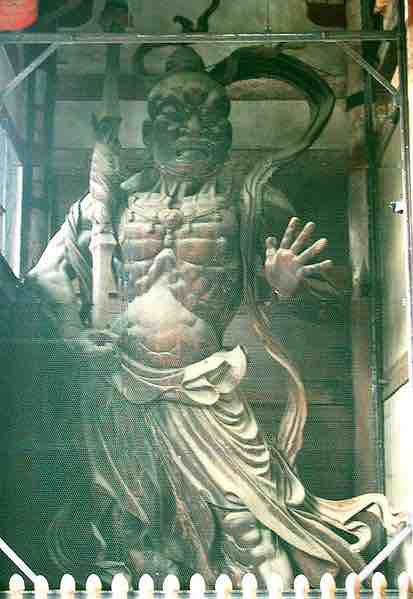Introduction
Japan suffered a series of civil wars in the late 12th century between several rival families. These wars eventually led to the rise of the feudalistic Kamakura shogunate. In a time of disunity and violence, deepening pessimism increased the appeal of the search for salvation. Kamakura was the age of the great popularization of Buddhism, and the reestablishment of cultural ties with China spawned the growth of Zen Buddhism and Pure Land Buddhism (Jōdo shū Shinran) as the two major branches of Japanese Buddhism. These two new sects dominated the artwork produced during the period.
The Rise of Buddhism
During this time, a number of monks who had left the Tendai sect founded separate Buddhist sects of their own. These included:
- Hōnen, founder of Japanese Pure Land Buddhism;
- Shinran, disciple of Hōnen and founder of the Jōdo Shinshū sect;
- Ippen, founder of the Ji sect, which emphasized devotion to Amida Buddha through an ecstatic dance;
- Dōgen, founder of the Sōtō school of Zen;
- Eisai, founder of the Rinzai school of Zen; and
- Nichiren, founder of the Nichiren Sect, which emphasized devotion to the Lotus Sutra, a manual of Buddhist aphorisms presented as a discourse from the Buddha.
The older Buddhist sects, such as Shingon, Tendai, and the early schools of the Nara period, continued to thrive through the Kamakura period and even experienced some measure of a revival. However, the older schools were partially eclipsed as the newer Kamakura schools increased in popularity and found followers among the new Kamakura government and its samurai.
Zen was not introduced as a separate school until the 12th century, when Myōan Eisai traveled to China and returned to establish a Linji lineage, which eventually perished. Decades later, Nanpo Shōmyō (南) (1235–1308) also studied Linji teachings in China before founding the Japanese Otokan lineage, the most influential and only surviving lineage of Rinzai in Japan. In 1215, Dōgen, a younger contemporary of Eisai's, journeyed to China himself, where he became a disciple of the Caodong master Tiantong Rujing. After his return, Dōgen established the Sōtō school, the Japanese branch of Caodong. The Sōtō school was further expanded by Keizan: Sōtō priests say that if Dogen is the father of Japanese Sōtō Zen, Keizan Jokin (1268-1325) is its mother. Keizan's Soji-ji temple was a rival to Dogen's Eihei-ji. Others say that Dōgen gave Sōtō Zen "high religious ideals" while Keizan ensured Sōtō's survival.
Painting in the Kamakura Period
Painting from the Kamakura Period largely continued the traditions of the previous Heian Period. As most of the paintings in both the Heian and Kamakura periods were religious in nature, the vast majority were by anonymous artists. Painted mandalas were common, and many were created as hanging scrolls and as murals on the walls of temples. The classic yamato-e style of Japanese painting, which gained significance in the Heian period, was continued throughout this era. Stylistically, painting included landscape elements such as soft rolling hills that seem to reflect something of the actual appearance of the landscape of western Japan, and works continued to be informed by Tang Dynasty Chinese "blue and green style" landscape painting traditions.
Paintings were used to decodate sliding doors (fusuma) and folding screens (byōbu). In addition, the emaki format of painting, consisting of long illustrated handscrolls, continued in popularity. The Kamakura Period witnessed the production of a large number of emaki, usually encompassing religious, historical, or illustrated novels, accomplished in the style of the earlier Heian period.
Kamakura Sculpture
While painting continued to develop throughout the period, sculpture was by far the most popular art form. The Kamakura period is widely regarded as a renaissance era in Japanese sculpture, spearheaded by the sculptors of the Buddhist Kei school. Based in Nara, the Kei school was the dominant school in Japanese Buddhist sculpture into the 14th century. Artist of the Kei school succeeded the technique "yosegi-zukuri" (Woodblock construction) and represented a new sculptural style marked by realism, solidity, and representation of movement and emotion. These artists studied early Nara period masterpieces and Chinese Song dynasty sculptures and paintings to influence their work. Sculptors of the time often worked for the Kamakura shogunate and other military clans, producing Buddhist sculptures as well as portrait sculptures.
The Kei school was responsible for the restoration of the temples of Nara and Kyoto, which had been destroyed during warfare in 1180-1185. Among the sculptors of this era, the sculptor Unkei is the most famous and accomplished. His most famous works include a pair of Kongō-rikishi colossal statues in the Tōdai-ji temple of Nara, along with the elaborate portraiture-like statues of Indian priests in Kōfuku-ji. Unkei had six sons who were also sculptors, and their work, like his, is imbued with the new kind of realism and humanism. Tankei, the eldest son and a brilliant sculptor, became the head of his father's studio. Kōshō, the 4th son, produced a remarkable sculpture of the 10th-century Japanese Buddhist teacher Kuya (903-972).

Nio guardian, Todai-ji complex, Nara
Agyō, one of the two Buddhist Niō guardians at the Nandai-mon in front of the Todai ji in Nara. These are some of the finest wooden sculptures in Japan from the 13th century carved by the Kamakura-era sculptor Unkei in 1203.
Kaikei was another famous sculptor of the time, a collaborator of Unkei, and a devout adherent of Pure Land sect of Buddhism. He worked closely with the priest Chōgen (1121–1206) on the reconstruction of the Tōdai-ji temple in Nara. Many of his figures are more idealized than that of Unkei and his sons and are characterized by a beautifully finished surface, richly decorated with pigments and gold. Perhaps his most important work is Amitabha Triad of Ono Jōdo-ji (1195).
Kaikei, wood-colored Buddha
Many of Kaikei's figures are more idealized than that of Unkei and are characterized by a beautifully finished surface, richly decorated with pigments and gold.